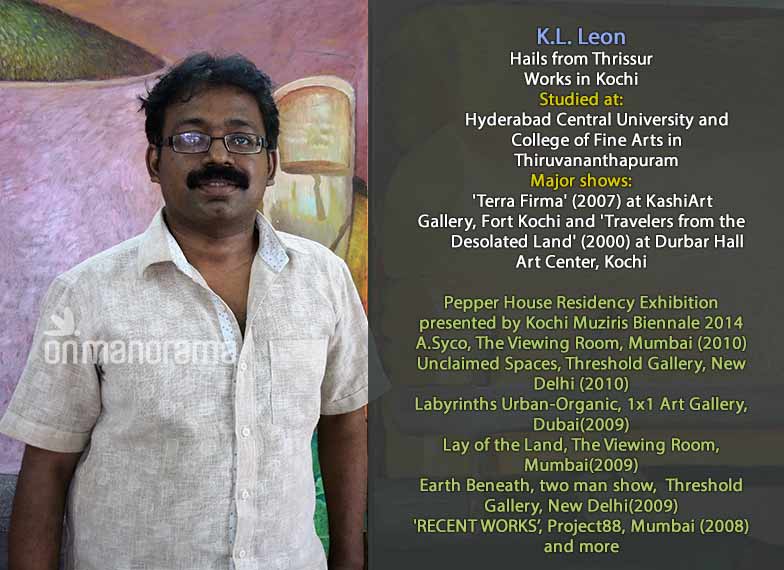K.L Leon is an artist who translates memory onto canvas. His canvas begets material not merely from the 'personal', but a collective memory. Images that represent the bygone days, people, ideas and the ways of life repeatedly appear in his works that prompt the viewer to ruminate on the past and review the present.
The brilliance in Leon's works lies in the way he positions daily-life objects with certain ideas, often symbols carved out of historic, religious and political spheres. Amid the objects representing lives that unravel in storerooms and backyards, one can sometimes spot a red flag or a martyr's tomb or a religious figure like St George or St. Sebastian.
"I believe in the idea of showcasing. It is more like collecting things from your surroundings or memory and arranging them in a specific order for others to watch," Leon says sitting in his studio near Vyttila in Kochi where he is currently working on a series of four paintings.
The works in progress are a continuation of his idea of art that has both the concepts of showcasing and realization of collective memory in their core; huge earthen pots filled with grains, sprouting coconuts, household tools like sickle, axe and shovel, ripened banana, elephant yams, aluminium vessels—the list of the objects manifested on canvas in concrete and abstract forms goes on. Several of Leon's works feature such daily life objects that have the power to take you down the memory lane. The images are often concrete and done in detail, unlike how the works of an academically trained contemporary artist is expected to be. But they are not mere reprints of a life lived by a dead community. They are often a mixture of myth and reality.
"I take symbols from religious and political spheres. But I try to look at them from a different angle," Leon says, explaining how he viewed St. Sebastian as a religious martyr. However, Leon does not believe in offering dogmas with regard to how his works should be viewed or interpreted. "A painting is not merely something that conveys a meaning. It's up to the viewer to decide how she should read a work," he says.
Check out other stories from the world of fashion and beauty
On the process of work, Leon feels it's an organic growth. "I arrive at a thought somehow and then start working on it. Similar is the case with the choice of the medium too. I basically start work with a structure in my mind, the rest of the work evolves in the process of painting," he says.

About the fondness for concrete and detailed images, Leon thinks perhaps it's a quality of the science student that he once was. "When I study an object, for example elephant yam, I try to understand its scientific aspects too. I observe it closely, which is the reason for the kind of detailing in my work."
People in fashion | Meet Binoodha Sasi: Pix, Video
Asked if the circumstances in Kochi permit one to make a living as a professional artist, Leons said there have been positive changes in the state's art scenario of late. However, he feels art is yet to become part of the people's daily life in the state. He also pointed out the scarcity of properly functioning galleries. He thanked the Kochi-Muziris Biennale primarily, for it offers a chance to watch art works by eminent artists from various parts of the world.
Hailing from Mattam near Guruvayur in Thrissur district, Leon has a bachelor's degree in Botany from Calicut University apart from BFA from College of Fine Arts in Thiruvananthapuram and Master's in Painting from Hyderabad Central University (2003) where he was a gold medalist too. His two major solo exhibitions are 'Terra Firma' (2007) at KashiArt Gallery, Fort Kochi and 'Travelers from the Desolated Land' (2000) at Durbar Hall Art Center, Kochi. His works were featured in a number of group shows across the country.
A recipient of residency with scholarship and studio practice at Kanoria Centre for Arts, Ahmedabad (2005-07), he recently completed the Pepper House Residency program initiated by Kochi Biennale Foundation.
The 42-year-old artist's wife Jify is a school teacher and the couple has two daughters.
(This is the first article in the series, “Kerala Canvas”, featuring contemporary artists from Kerala. Watch this space for more on the current art scene and artists in the state.)

























 K.L. Leon in his studio at Vyttila in Kochi. Photo: Onmanorama
K.L. Leon in his studio at Vyttila in Kochi. Photo: Onmanorama







